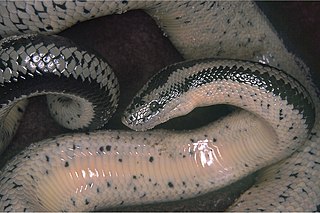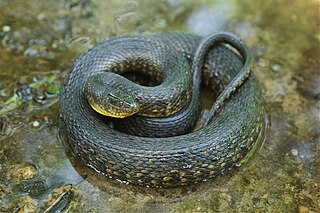
The desert rosy boa is a species of snake in the family Boidae. The desert rosy boa is native to the American Southwest and Baja California and Sonora in Mexico. The desert rosy boa is one of four species in the boa family native to the continental United States, the other three being the coastal rosy boa and the two species of rubber boas (Charina).

Hypsiglena is a genus of small, rear-fanged, colubrid snakes commonly referred to as night snakes. The genus consists of nine species, and subspecies have been maintained pending further investigation.

Pituophis catenifer affinis, commonly known as the Sonoran gopher snake, is a nonvenomous subspecies of colubrid snake that is endemic to the southwestern United States. It is one of six recognized subspecies of the gopher snake, Pituophis catenifer.
Hypsiglena torquata, the night snake, is a species of rear-fanged colubrid. It is found in Mexico.

Nerodia rhombifer, commonly known as the diamondback water snake, is a species of nonvenomous natricine colubrid endemic to the central United States and northern Mexico. There are three recognized subspecies of N. rhombifer, including the nominotypical subspecies.

The San Francisco garter snake is a slender multi-colored subspecies of the common garter snake. Designated as an endangered subspecies since the year 1967, it is endemic to San Mateo County and the extreme northern part of coastal Santa Cruz County in California.

Crotalus viridis nuntius is a venomous pit viper subspecies native primarily to the desert plateau of the northeastern portion of the American state of Arizona, but also ranges into northwestern New Mexico. Named for the Native American Hopi tribe, which inhabits the region, its range overlaps that of the nominate subspecies and some interbreeding is believed to occur. The taxonomy of the C. viridis group is a matter of debate, many considering the various subspecies to be nothing more than locality variations.

Hypsiglena jani, commonly known as the Texas night snake or the Chihuahuan night snake, is a small species of mildly venomous snake in the family Colubridae. The species is native to the southwestern United States and adjacent northeastern Mexico.

The western ground snake is a species of small, harmless colubrid snake. The species is endemic to North America. Its patterning and coloration can vary widely, even within the same geographic region. Another common name is miter snake referring to the head marking which suggests a bishop's miter; the synonym "episcopus " is a similar allusion.

The banded water snake or southern water snake is a species of mostly aquatic, nonvenomous, colubrid snakes most commonly found in the Midwest, Southeastern United States and Caribbean.

The Florida crowned snake is a species of colubrid snake found in Florida and Georgia. It is a small, slender, non-venomous snake that is rarely seen. The species is commonly found in north and central Florida, and is most often associated with sandy habitats.

The green water snake is a common species of nonvenomous natricine snake endemic to the southeastern United States.

The midland water snake, a subspecies of the northern water snake, is a nonvenomous natricine snake, which is endemic to North America.

Thamnophis proximus, commonly known as the western ribbon snake, is a species of garter snake in the subfamily Natricinae of the family Colubridae. The species is endemic to the western United States, Mexico, and Central America. The species has six recognized subspecies.

The common watersnake is a species of large, nonvenomous, common snake in the family Colubridae. The species is native to North America. It is frequently mistaken for the venomous cottonmouth.
Hypsiglena unaocularus, commonly known as the Islas Revillagigedo night snake or Clarión night snake, is a species of small colubrid snake endemic to Clarion Island, initially described from a single specimen collected by William Beebe in 1936. During the next several decades, scientists were unable to detect any trace of the snake in their field studies. After an intensive search in 2013, a team of scientist identified 11 snakes that matched the original description of the species. They conducted a series of DNA tests to confirm that the Islas Revillagigedo nightsnake, formerly viewed as the subspecies Hypsiglena torquata unaocularis, is genetically distinct from related mainland snakes and should be recognized as a full species. While never formally declared extinct, this species remained absent from scientific literature due to two main factors: its home on Clarion is extremely remote and only accessible by military escort, significantly restricting the number of biologists who can access this area, and the snake's secretive, nocturnal behavior and dark coloration make it difficult to detect in the field. Because of the lack of follow-up sightings, scientists long presumed that Beebe had provided an incorrect locality for his specimen.














